What causes the wind to blow?
As the sun warms the Earth's surface, the atmosphere warms too. Some parts of the Earth receive direct rays from the sun all year and are always warm. Other places receive indirect rays, so the climate is colder. Warm air, which weighs less than cold air, rises. Then cool air moves in and replaces the rising warm air. This movement of air is what makes the wind blow.
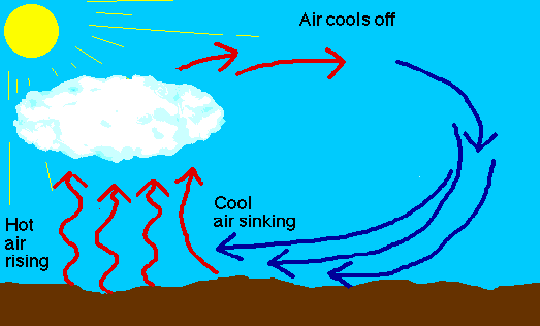
Geology of Wind Energy and Landscape
Wind energy requires wind. The ideal place for wind is open plains, hilltops near or even on large open bodies of water. What is needed geologically for wind energy to be successful? As already mentioned above, you need the sun’s energy heating both the water and the land (both of which are ideally close together). You also need a geologic landscape largely devoid of trees and other “wind obstructions." The open plains need to be 93% or more clear to provide the necessary open space for wind energy, while hilltops need to be only 10% “clear” to provide that necessary wind space, and passes or ravines need to only be 40% clear to provide the necessary wind tunnel. Of course, no one would even think of creating a wind farm in an enclosed valley or forest, since there's no free space! The landscape in front of you is open and arable farmland mostly cleared of trees and very close to a very large object that produces strong and consistent winds blowing 'inland'.
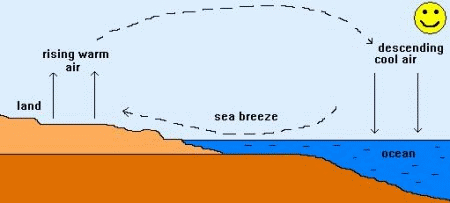
Wind Erosion
The term wind erosion refers to the damage of land as a result of wind removing soil from an area. Most often, wind erosion occurs on flat land in dry or sandy areas. For example, rock formation in various locations can be sculpted by wind erosion, dunes, particularly in deserts, off of which sand is blown and various rock or sand structures created via wind blowing off rock and sand around them. Wind erosion can happen anywhere and anytime the wind blows. Wind erosion can occur in any area where the soil or sand is not compacted or is of a finely granulated nature. Wind erosion can result in a variety of types of movement of the soil. Three different types of soil movement include suspension, creep, and saltation. Suspension occurs when the wind takes fine particles of dirt and dust into the area and can move said particles over long distances. Creep occurs when soil particles roll over an area and meet particles that have been through saltation. Saltation is the primary means of soil movement. Wind erosion can cause any of these different types of soil movement, resulting in erosion of the land.
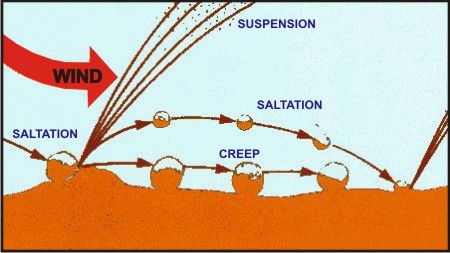
Deflation and abrasion
Another way of considering wind erosion types is to consider deflation and abrasion. Deflation is the process by which wind moves particles that are loose and abrasion is when an area is eroded directly by airborne particles. This is particularly evident 16km to the southeast at Sandhill Park where the sand dunes there are being etched by the process of abrasion.
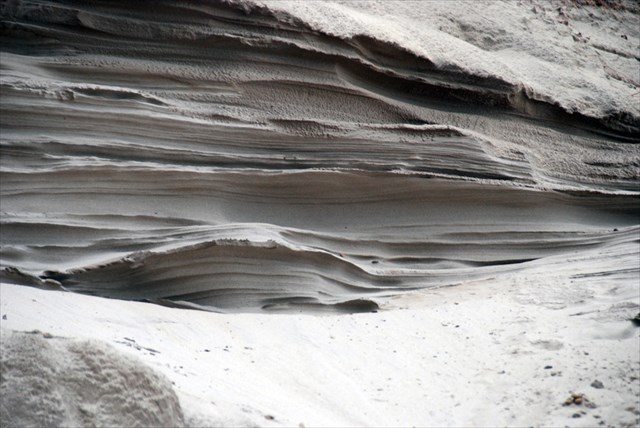
Reducing erosion of land by effects of wind
Proper crop placement, dealing appropriately with crop residues, and effective planting can all lower the impact of wind erosion as well as increasing vegetation by planting on the land, the ability of the wind to remove soil is greatly reduced, creating wind-breaks, by arranging the planting of trees around an area.
Capturing the wind's power
Winds can be used to generate electricity. Using wind turbines, the kinetic energy of the wind is converted to mechanical energy, which is then used to produce electrical energy. Most turbines consist of a set of blades connected to a generator.
Wind turbines, like aircraft propeller blades, turn in the moving air and power an electric generator that supplies an electric current. Simply stated, a wind turbine is the opposite of a fan. Instead of using electricity to make wind, like a fan, wind turbines use wind to make electricity. The wind turns the blades, which spin a shaft, which connects to a generator and makes electricity.
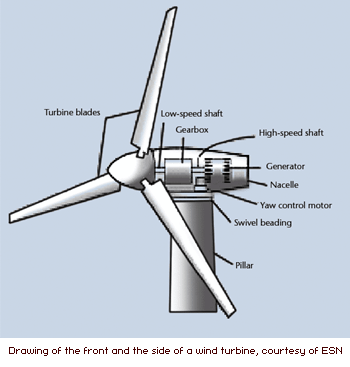
Wind turbines like the ones you see around you consist of a blade or rotor, which converts the energy in the wind to rotational shaft energy; a drive train, usually including a gearbox and a generator; a tower that supports the rotor and drive train; and other equipment, including controls, electrical cables, ground support equipment, and interconnection equipment.
Wind energy is a free, renewable resource, so no matter how much is used today, there will still be the same supply in the future. It is also a source of clean, non-polluting, electricity. Wind plants emit no air pollutants or greenhouse gases. Even though the cost of wind power has decreased dramatically in the past 10 years, the technology requires a higher initial investment than fossil-fueled generators. Roughly 80% of the cost is the machinery, with the balance being site preparation and installation. There are concerns with their impact on the environment and safety. The main concern is over the noise produced by the rotor blades, aesthetic (visual) impacts, and birds and bats having been killed by flying into the rotors. The major challenge to using wind as a source of power is that it is intermittent and does not always blow when electricity is needed. Wind cannot be stored (although wind-generated electricity can be stored, if batteries are used), and not all winds can be harnessed to meet the timing of electricity demands. Further, good wind sites are often located in remote locations far from areas of electric power demand (such as cities). Wind resource development may also compete with other uses for the land, and those alternative uses may be more highly valued than electricity generation. However, wind turbines can be located on land that is also used for grazing or even farming.
The output of a wind turbine depends on the turbine's size and the wind's speed through the rotor. Wind turbines manufactured today have power ratings ranging from 250 watts to 7 MW. An onshore wind turbine with a capacity of 2.5 MW can produce more than 6 million kWh in a year - enough to supply 1,500 average households with electricity.
To log this earthcache send me the answers to the following questions;
1. How many wind turbines can you see from GZ?
2. From the information boards in the park how many Megawats of power does it say are generated by wind in the Province of Ontario? And in the Erie Shores Wind Farm of the Port Burwell area what is the total number of turbines in that wind farm and what is its total combined capacity (MW)?
3.What kind of energy is the wind?
4. On the date of your visit how many rpms (revolutions per minute) is the closest turbine (just to the northeast of the park) turning?
5. Describe the landscape before you. Treeless or some trees? Flat or rolling? Open and bare or open with crops?
6. What major geological feature, hilltop, flat plain or open water, lies just a few kilometres to the south? What is its name? This feature is a major contributor to the winds in this area and why this wind farm is where it is.
7. If you walk to the north of the park and look to the road running to the north, is there any evidence of soil erosion? Is there any soil blowing across the road? Do you see any evidence of attempts made to stop soil erosion? Wind breaks etc? What about the trees, is there any evidence of the effect of the wind on the nearby tree?
You do not need to hear back from me with an okay. You may go ahead and log your 'found it' log. I will only contact you if your answers are incorrect or they are not sent in.
Congratulations to chartmaker for the FTF